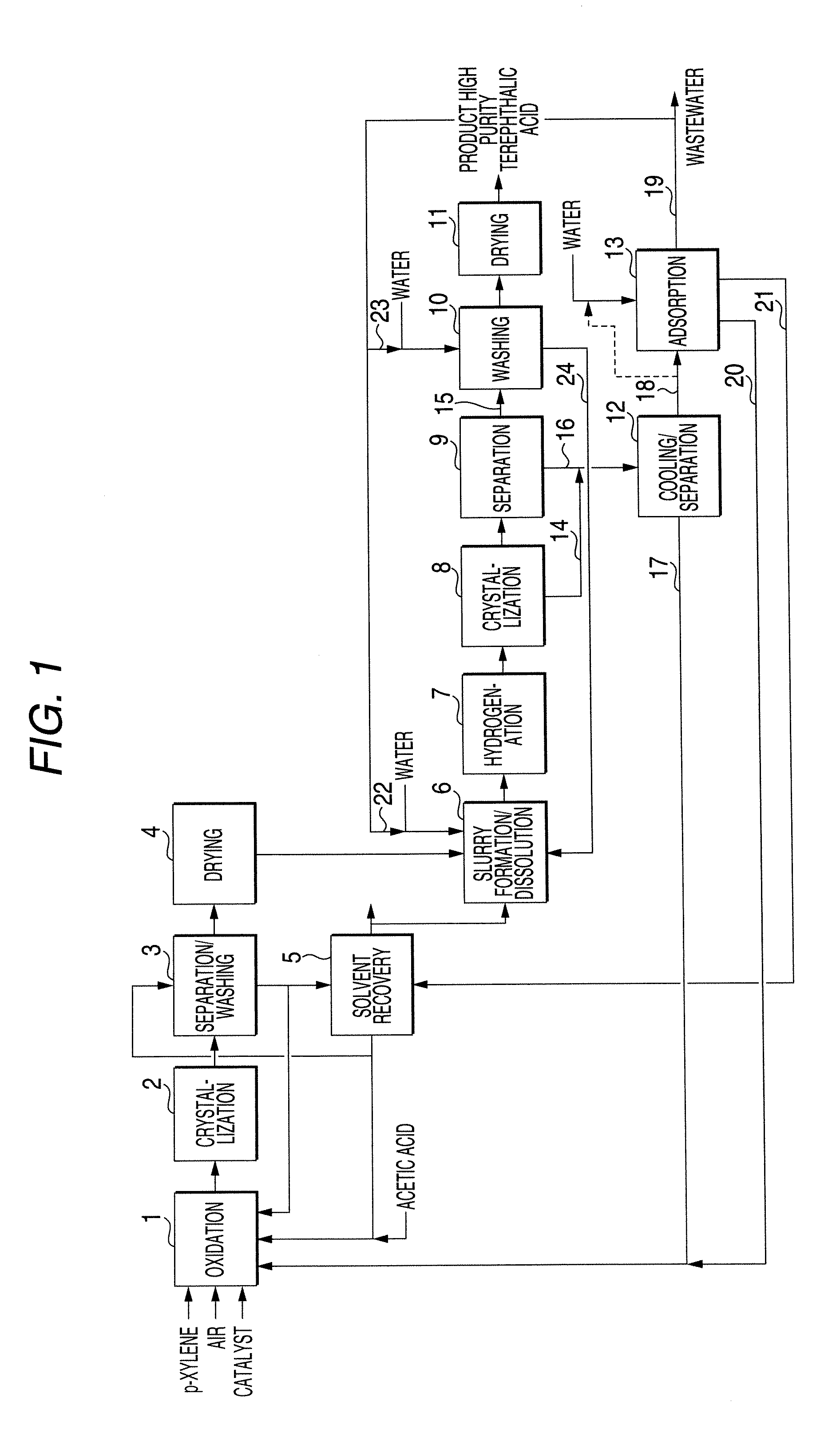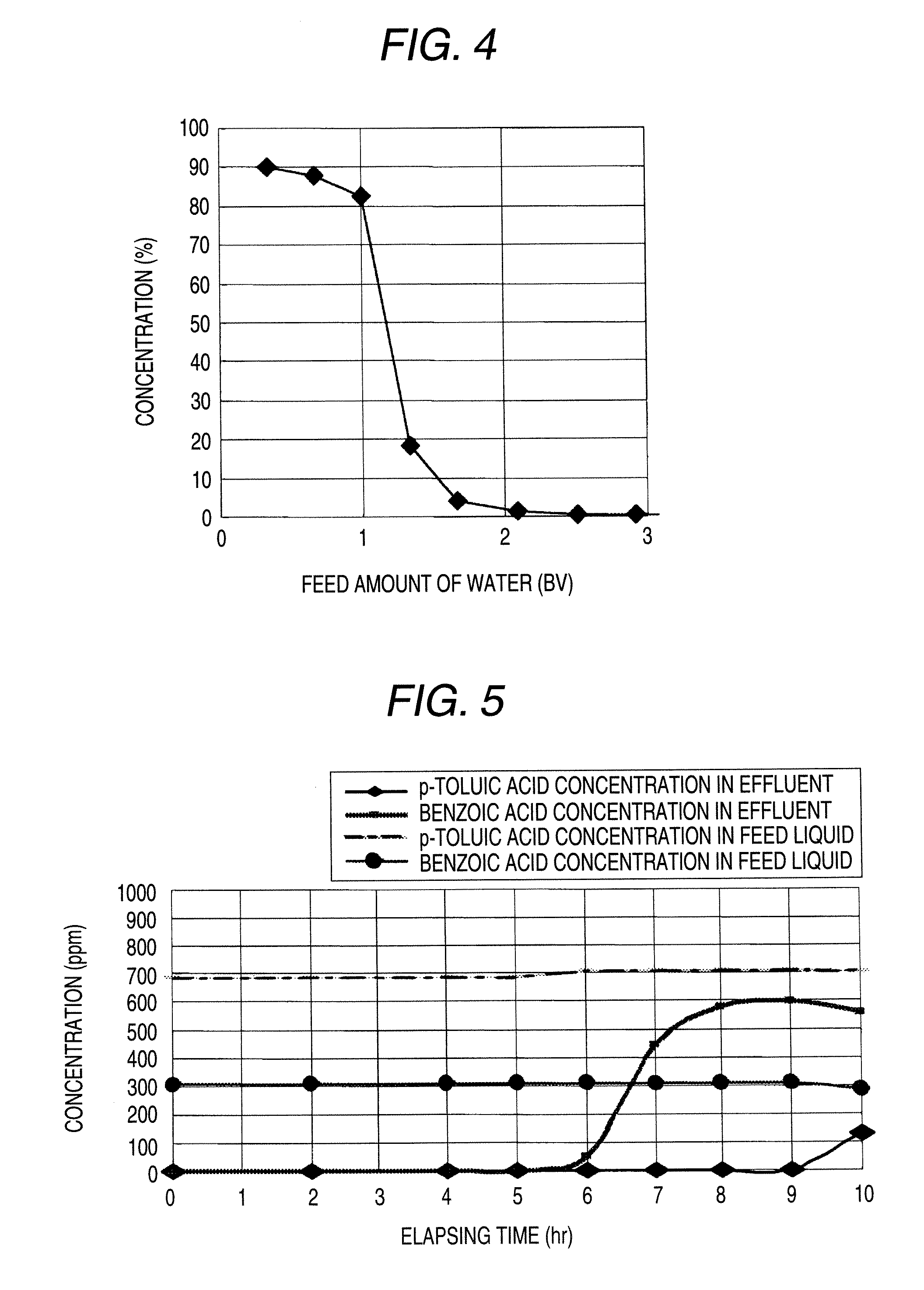Process of producing high purity terephthalic acid
a terephthalic acid, high-purity technology, applied in the preparation of carboxylic compounds, organic chemistry, chemistry apparatus and processes, etc., can solve the problems of environmental pollution and huge treatment costs, and achieve the effect of reducing the cost and increasing the yield of terephthalic acid
- Summary
- Abstract
- Description
- Claims
- Application Information
AI Technical Summary
Benefits of technology
Problems solved by technology
Method used
Image
Examples
example 1
[0096]18.8 g (33 mL) of a synthetic adsorbing agent SEPABEADS SP825L, manufactured by Mitsubishi Chemical Corporation was weighed in a beaker and formed into a slurry by using methanol; and after thoroughly degassing, the slurry was poured into a glass column having an inside diameter of 17.8 mm. The slurry was washed with pure water, and it was confirmed by gas chromatography that methanol had not be detected.
[0097]An aqueous solution containing p-toluic acid and benzoic acid was continuously fed into this column at 338 mL / hr, thereby achieving an adsorption treatment. The feed was carried out at SV=10 hr−1 and LV=1.4 m / hr. Concentrations of p-toluic acid and benzoic acid in a feed liquid and an effluent were periodically measured. The results are shown in FIG. 2.
[0098]Next, acetic acid containing 300 ppm of p-toluic acid and 7% of water was fed as a desorbing agent at SV=10 hr−1 into the foregoing column. Concentrations of p-toluic acid and benzoic acid in the desorbing agent flow...
example 2
[0100]A crude terephthalic acid slurry obtained by oxidizing p-xylene with air in an acetic acid solvent in the presence of a catalyst composed of a cobalt compound, a manganese compound and hydrogen bromide was subjected to solid-liquid separation to obtain a crude terephthalic acid crystal. An aqueous slurry containing this crude terephthalic acid crystal in a proportion of 30% by weight was heated to prepare an aqueous solution, which was then hydrogenated at 290° C. and 8.7 MPa in the presence composed of a catalyst of palladium supported on active carbon.
[0101]The hydrogenated aqueous solution was subjected to pressure release for cooling stepwise by a crystallization tank having five crystallization cans connected to each other in series and finally cooled to 155° C., thereby obtaining a high purity terephthalic acid slurry. This slurry was subjected to solid-liquid separation to obtain a high purity terephthalic acid crystal and a primary mother liquor. The high purity tereph...
example 3
[0107]0.5 g of a synthetic adsorbing agent SEPABEADS SP825, manufactured by Mitsubishi Chemical Corporation was added in 100 mL of an aqueous solution containing p-toluic acid in a concentration of 332 ppm, and the mixture was stirred at room temperature for 15 hours, thereby equilibrium adsorbing p-toluic acid. An amount of p-toluic acid adsorbed to the adsorbing agent was 27 mg.
[0108]This adsorbing agent was taken out from the aqueous solution, to which was then added 20 mL of methyl acetate, and the mixture was stirred at room temperature for 6 hours to desorb p-toluic acid. As a result, an amount of p-toluic acid in the desorbing agent was 27 mg.
[0109]This adsorbing agent was washed with 100 mL of water and then added in 100 mL of aqueous solution containing p-toluic acid in a concentration of 332 ppm, and the mixture was stirred at room temperature for 15 hours to again adsorb p-toluic acid. As a result, an amount of p-toluic acid adsorbed to the adsorbing agent was 23 mg, and ...
PUM
| Property | Measurement | Unit |
|---|---|---|
| temperature | aaaaa | aaaaa |
| temperature | aaaaa | aaaaa |
| pressure | aaaaa | aaaaa |
Abstract
Description
Claims
Application Information
 Login to View More
Login to View More - R&D
- Intellectual Property
- Life Sciences
- Materials
- Tech Scout
- Unparalleled Data Quality
- Higher Quality Content
- 60% Fewer Hallucinations
Browse by: Latest US Patents, China's latest patents, Technical Efficacy Thesaurus, Application Domain, Technology Topic, Popular Technical Reports.
© 2025 PatSnap. All rights reserved.Legal|Privacy policy|Modern Slavery Act Transparency Statement|Sitemap|About US| Contact US: help@patsnap.com



